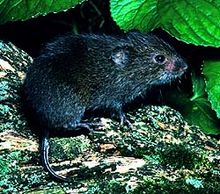Cricetidae facts for kids
Quick facts for kids CricetidsTemporal range: Middle Miocene - Recent
|
|
|---|---|
 |
|
| Meadow Vole Microtus pennsylvanicus |
|
| Scientific classification | |
| Kingdom: | |
| Phylum: | |
| Class: | |
| Infraclass: | |
| Superorder: | |
| Order: | |
| Suborder: | |
| Superfamily: | |
| Family: |
Cricetidae
J. Fischer, 1817
|
| Subfamilies | |
|
Arvicolinae |
|
The Cricetidae are a big family of rodents. They belong to an even larger group called Muroidea. This family includes many animals you might know. For example, it has true hamsters, voles, lemmings, and New World rats and mice. With almost 600 different kinds of species, it is the second largest family of mammals on Earth! You can find these animals in the New World (North and South America), Asia, and Europe.
Contents
What Are Cricetids Like?
Cricetids are usually small mammals. The smallest is the New World Pygmy Mouse. It is only about 5 to 8 cm long and weighs 7 grams. The largest is the Muskrat. It can be 41 to 62 cm long and weigh up to 1,100 grams.
Their tails can be different lengths. Some tails have a lot of hair, while others have very little. Most cricetids have brown fur. Their bellies are often white. However, there are many other fur patterns too. You can see these patterns especially in hamsters and voles.
Where Do They Live?
Like the Old World Mice, cricetids live in many different places. They can be found from the cold Arctic to hot deserts. They also live in steamy tropical rainforests.
Some cricetids are great at climbing. They have long tails that help them balance. Others are good swimmers. They have webbed feet and small ears that help them in water. Some cricetids dig burrows and live underground. Others live on the ground.
What Do They Eat?
Cricetids eat many different things. Some are herbivores, meaning they only eat plants. Others are omnivores, eating both plants and animals. Some are insectivores, eating mostly insects.
All cricetids have large front teeth called incisors. These are for biting and chewing. They also have grinding molar teeth. There is a gap between their incisors and molars. This gap is called a diastema.
Cricetids can have many babies very quickly. A mother gives birth after 15 to 50 days. They often have many young at once. The babies are usually born blind, without hair, and cannot take care of themselves.
How Are Cricetids Classified?
Scientists classify cricetids into one prehistoric group and five living subfamilies. There are about 112 living genera (groups of species) and around 580 living species.
Here are the main subfamilies:
- Arvicolinae - This group includes voles, lemmings, and the muskrat.
- Cricetinae - These are the true hamsters.
- Democricetodontinae - This is a group of cricetids that are now extinct.
- Neotominae - These are North American rats and mice. Examples include deer mice, pack rats, and grasshopper mice.
- Sigmodontinae - These are New World rats and mice. Most of them live in South America, like the brucies.
- Tylomyinae - This group includes New World climbing rats and their relatives.
Images for kids
-
Roborovski's dwarf hamster (Phodopus roborovskii) from the hamster subfamily.
See also
 In Spanish: Cricétidos para niños
In Spanish: Cricétidos para niños



